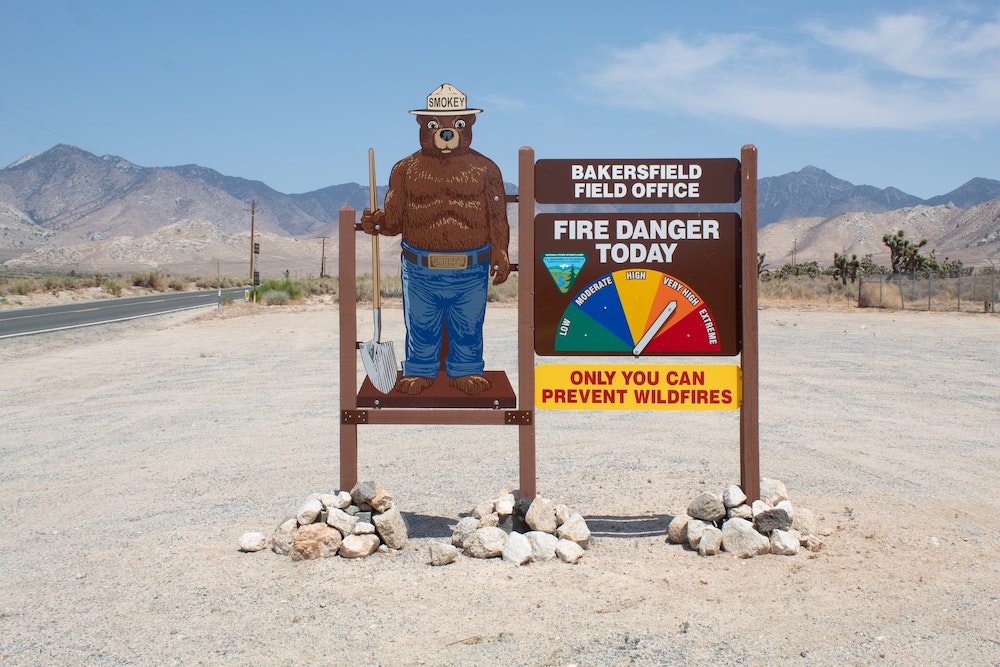
As the entire world continues to adapt to a changing climate, it’s an unfortunate reality that more and more animal sanctuaries are likely going to be put at risk of being affected by wildfires in the future. From the mountain west and the coasts of the United States and Canada, all the way to the Australian Bush, there have been growing reports of animal sanctuaries facing evacuation orders, coping with intense heat and smoke, and even finding wildfires at their doorstep. In this introductory resource, we’ll offer general guidance for sanctuaries and animal caregivers in areas that are at a higher risk for wildfire. Please keep in mind that these are just meant to be a starting point. Each sanctuary should work with experts in their area to determine the specific protocols they should have in place.
Checkout Your Region’s Wildfire Information
If you are in an area where wildfires are likely, your region probably has detailed information on the subject. For example, the California Department of Forestry and Fire Protection (CAL Fire) maintains readyforwildfire.org which is full of information about fire prevention, defensible space, creating evacuation plans, and much more. While you don’t have to be in California to make use of this information, you may find something similar geared specifically to your region!
Get (And Stay) Informed!
If you are in an area where wildfires are a concern, it’s important to familiarize yourself with the specifics of your region in terms of risk and information sharing. This includes:
- Figuring out what times of year wildfires are most likely to occur. This is often referred to as the “fire season”. Keep in mind that the worsening climate crisis has resulted in the fire season in some areas starting earlier and going longer than what was normal in the past.
- Identifying important information sources for staying up-to-date on fire conditions and active wildfires in your region. If available, sign up for mobile alerts.
- Learning about the different types of fire-related weather warnings in your region. In the US, the National Weather Service issues Fire Weather Watches and Red Flag Warnings. The criteria for each are created by local National Weather Services.
- Understanding what restrictions are in place and what activities should be avoided when the risk of wildfire is high.
- Knowing your evacuation zone.
Work With Your Local Fire Marshal Or Fire Authority
We cannot stress this point enough: your local fire responders are going to be your best source of information. Not only can they help you evaluate the risk your sanctuary faces, but they can also talk you through their response plan and capabilities, help you create a fire preparedness and response plan, and possibly even provide annual training for your staff and volunteers.
Site Visits
If they haven’t already been to your property, invite them out so they can:
- Explain the degree of risk based on your location, terrain, setup, and surrounding area
- Identify specific fire risks on your property and advise you on how to address them
- Determine if there are issues that could prevent emergency vehicles from accessing certain structures or portions of the property.
Are Your Roads Ready?
There are a range of fire response vehicles of varying sizes and weights, so learning what vehicles would most likely come to your property is important in order to make sure your property’s infrastructure can accommodate them. For example:
Can bridges support the vehicle’s weight?
Are roads and gates wide enough for vehicles?
Can vehicles turn around at each structure?
Having this information and identifying potential issues ahead of time allows you to remedy these issues before you are faced with an emergency.
Information For Your Fire Preparedness And Response Plan
In addition to the above, by becoming familiar with your property and setup, your local fire authority may be able to provide information to help you create your fire preparedness and response plan, described below. This may include helping to identify areas on your property that would be easier to defend against fire (and could potentially act as safe spaces for residents during a fire) and helping you determine if you should invest in a water storage system or particular fire-fighting equipment.
Staff Training
Representatives from your local fire agency may be willing to conduct annual training for your staff and volunteers to ensure they have a better understanding of how fire “behaves” and know what to do should there be a fire on or approaching the sanctuary.
Create A Fire Preparedness And Response Plan
The most effective plan is going to be one that is tailored to your specific sanctuary, so we strongly urge you to work with your local fire authority to develop your plan. Your plan should be reviewed and updated regularly, and your staff and volunteers should be well acquainted with its contents. While each sanctuary is going to have their own unique plan, there are some general topics that should be covered. While not an exhaustive list, your fire plan should consider the following questions:
- What needs to be done in order to prepare for fire season?
- Is there a way to make the property safer and to reduce the amount of material/vegetation that could fuel a fire (such as overgrown brush, dry grass, wood piles, etc.)? We discuss this a bit more later in this resource.
- What training do staff and volunteers need in order to be prepared for fire season?
- Do any supplies need to be replenished or replaced, particularly those necessary for safely moving residents if needed (for example, carriers and halters)?
- Has protective equipment (such as fire extinguishers, sprinklers, etc.) been inspected?
- Are transport vehicles in good working order?
- How will staff and volunteers stay informed of current fire conditions?
- What activities should be avoided and what precautions should be taken when there are fire-related weather warnings in your area?
- What emergency supplies should be on hand?
- How will you respond to service interruptions?
- Who is in charge of decision-making and what is everyone’s responsibility in carrying out the fire plan?
- What is the plan for fire-related situations, such as:
- If there is a fire in the area that has the potential to eventually reach the property, but the danger is not imminent?
- If non-mandatory evacuation orders* are in place?
- If mandatory evacuation orders* are in place?
- If the threat of fire is imminent but evacuation of residents is not possible?
- If a fire starts on the property?
- Are there certain parts of the property that are safer or more easily defended against fire?
- In the event of a fire on or near the property, what measures are in place to protect structures from embers?
- How will staff and volunteers be kept safe?
The Importance Of Identification
While it’s uncomfortable to think about, should your property be affected by wildfire, it’s important to consider the fact that you may find yourself dealing with loose residents in the aftermath. A scared resident might flee if they are able, and in some situations, emergency responders may decide that the only way to try to save your residents is to let them out of their fenced area. Ensuring all of your residents have some form of ID is imperative to facilitate their safe return.
Microchips are a wonderful form of ID, but in an emergency situation, if people don’t have a microchip reader on them, or cannot get close enough to use it, they’ll have no way of making use of the ID. Because of this, if microchips are the only type of ID used for certain residents, you may want to consider adding a visible form of ID if the risk of fire affecting your property is high. A common recommendation for horses, which would also work for other larger residents, is to use animal-safe spray marker to write your phone number on the individual. By writing the number so that it can be seen from a distance, folks can report sightings even if they are unable to restrain the individual.
*Evacuation Considerations
When creating evacuation plans, be sure to:
- Identify multiple evacuation routes and drive them with your largest vehicles to ensure there are no potential issues (such as an overpass that is too low)
- Identify possible evacuation sites ahead of time (this might include your local fairground, equestrian centers, other sanctuaries, etc.)
- Consider what is necessary to successfully evacuate everyone (in terms of humans, supplies, physical setup, vehicles and equipment, time, number of trips, etc.)
- If you’ll need to rely on additional support (in terms of volunteers, trailers, etc.) connect with these folks ahead of time
- Consider if you can evacuate everyone at once or if you will need to do so in multiple trips (such as if you do not have enough trailers to accommodate everyone at once). Keep in mind that conditions can change quickly and there is always a chance that while one group is being evacuated, roads will be closed, preventing personnel and vehicles from returning to the property.
- Identify ways to make the evacuation process easier. For example, if you have residents who are difficult to restrain or load into a trailer, dedicating time to making them more comfortable with this process is important.
- Identify ways to make evacuation faster. For example, it’s a good idea to have trailers hooked up and ready to go and to make sure all vehicles have at least a half tank of gas. For evacuation of smaller residents, having any necessary carriers put together, clearly labeled, and stored in the areas where they will be needed can save time when every second counts.
- Consider how you will care for residents at the evacuation site and how you will keep them safe. What supplies will you need? Can you have these prepared and ready to go ahead of time?
- Do your residents have identification such as leg bands? Are there additional temporary ID methods you should have ready to go such as animal-safe spray markers and/or disposable ID collars?
- What records will you need to bring with you? (think proof-of-vaccination, health histories, etc.). How can you have these ready to go ahead of time? Do you have digital backups?
Prepare For The Aftermath
We hope you never have to deal with a fire on your property, but it’s important to note that if your property or the surrounding area is impacted by a wildfire, the risk doesn’t end when the fire is extinguished. Wildfires can leave land vulnerable to landslides and flooding, so it’s important to be aware and prepared to respond to additional emergencies.
Take Time To Prepare For The Fire Season Each Year
Every year before the fire season starts, there are important things to do. Be sure to schedule everything you have identified in your fire plan as having to happen in order to prepare for fire season (such as staff trainings, brush clearing, fire marshall visits, etc.). Additionally:
- Make sure emergency contacts are up-to-date
- Review your fire plan and make updates if needed
- Make sure your address is clearly marked and can be seen both at night and when visibility is limited (this is important to avoid delays due to the fire department not being able to find your property)
- Make sure animal counts in each location are up-to-date
- Make sure all gates are in working order

Don’t Lock The Fire Department Out!
If your property is locked, be sure your fire department has what they need to enter the property. Without access to the necessary key or code, their response could be slowed, and during a fire, every second matters!
Preparing Your Property For Fire Season
As we’ve stated throughout this resource, your local fire authority is going to be your best source of information for how to prepare for wildfires. However, there are some general recommendations regarding how to reduce fuel loads on your property in order to mitigate the risk of structures catching fire and to make it easier for emergency responders to defend your property if necessary. Be aware that the specific recommendations (or requirements) in your area may differ from those below. Unless otherwise noted, the following information comes from The National Fire Protection Association and is geared toward protecting homes, but provides a good example of how to prepare your property for fire season.
- In the Immediate Zone (extending 5 feet around structures) create a “non-combustible area” that is protected from ember ignition by:
- Keeping roofs and gutters clear of leaves, pine needles, and other debris
- Repairing or replacing loose, missing, or damaged roofing
- Covering vents and other gaps or openings with ⅛ inch metal screen to prevent embers from getting inside structures
- Keeping vents clear of debris
- Keeping flammable materials away from structure walls (this includes pine needles, fallen leaves, flammable vegetation, mulch, wood piles, etc.). Since wood fencing that butts up against structures poses a hazard, OSU Cooperative Extension suggests using metal gates as a buffer between structures and wood fencing.
- In the Intermediate Zone (extending 30 feet around structures):
- Use roads and walkways to create fuel breaks
- Keep grasses shorter than 4 inches
- Keep area under propane or other fuel tanks cleared of vegetation
- Remove vegetation from under trees
- Remove all tree branches that are within 6 feet of the ground (this is not possible for shorter trees – in these cases, follow your fire agent’s recommendations regarding pruning)
- Maintain at least 18 feet between tree crowns (space recommendations will increase on sloped terrain)
- Maintain at least 10 feet between tree crowns and structures
- Keep trees and shrubs limited to small clusters to break up potential fuel sources
- In the Extended Zone (30-200 feet around structures):
- Remove dead vegetation and avoid heavy accumulations of plant debris
- Do not allow small conifers to grow between mature trees
- In the area 30-60 feet from structures, maintain at least 12 feet between tree canopies (more distance may be recommended depending on terrain slope and tree species)
- In the area 60-100 feet from structures, maintain at least 6 feet between tree canopies (again, more may be recommended based on terrain slope and tree species)
- OSU Cooperative Extension and CAL Fire recommend further reducing fuel loads by keeping grasses in this zone to 4 inches or shorter
Build And Repair With Fire Prevention And Protection In Mind
If you are building new structures or conducting repairs, be sure to consider if this is another opportunity to prepare for wildfires. Whenever possible, opt for fire-resistant materials (such as metal roofing). Also be sure to consider the placement of new structures in relation to forested areas or roads, which could increase the risk of the structure being impacted by fire.
Getting Started
If you don’t have a wildfire preparedness and response plan in place yet but are in an area where your sanctuary could be at risk, don’t panic. Take a deep breath, and decide that today is a good day to get started. We recommend you start by:
- Contacting your local fire agency
- Identifying other regional resources about wildfire preparedness
- Checking out our fire safety resource for general tips on fire safety (including a downloadable checklist)
- Start working on contingency planning
Unfortunately, as with many other things in the world, we cannot control everything that goes on around us. Even with the most robust fire plans in place, we cannot prevent lightning strikes, downed power lines, or other humans engaging in activities beyond our property that pose a fire risk. What we can do is get informed, make important connections, and identify the things we can control that will help keep our residents and those who care for them safe. When it comes to wildfire, that means taking measures to make your property less conducive to fire and more easily defendable and having actionable plans in place for the various wildfire-related situations that may arise.
Acknowledgments
We extend our deepest gratitude to the folks at Animal Place and Edgar’s Mission, without whom this resource would not have been possible.

SOURCES:
Preparing Homes For Wildfire | National Fire Protection Association
Defensible Space | Ready For Fire
How To Respond To Fire | ASPCA
Saving The Ranch | Michael Payne DVMDoctor of Veterinary Medicine, an academic degree awarded to veterinarians in many countries.. PhD (Content Warning: Images and discussion of deceased animals and animals in grave danger)
Definitions of a Fire Weather Watch And A Red Flag Warning | National Weather Service
Did You Know Red Flag | CAL Fire TV
Identification For Horses During Disasters | The Horse
Study: Fire Seasons Getting Longer, More Frequent | NASA
Wildfire: Preparing The Ranch And Farm | OSU Extension (Non-Compassionate Source)
Non-Compassionate Source?
If a source includes the (Non-Compassionate Source) tag, it means that we do not endorse that particular source’s views about animals, even if some of their insights are valuable from a care perspective. See a more detailed explanation here.








